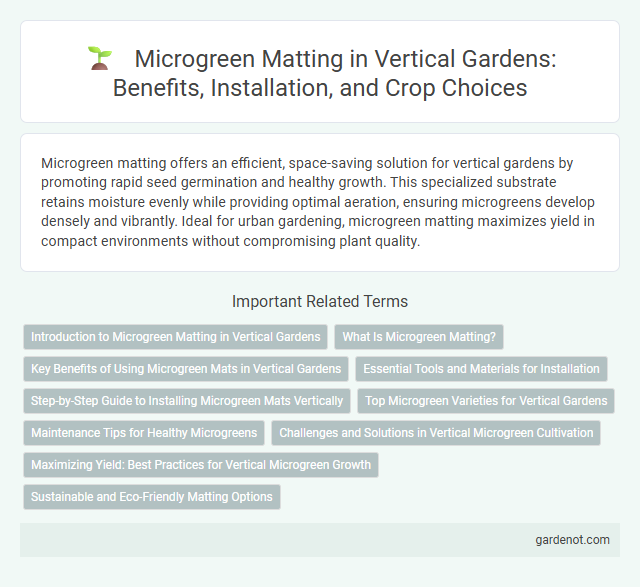Microgreen matting offers an efficient, space-saving solution for vertical gardens by promoting rapid seed germination and healthy growth. This specialized substrate retains moisture evenly while providing optimal aeration, ensuring microgreens develop densely and vibrantly. Ideal for urban gardening, microgreen matting maximizes yield in compact environments without compromising plant quality.
Introduction to Microgreen Matting in Vertical Gardens
Microgreen matting in vertical gardens serves as a nutrient-rich growing medium designed to optimize space and enhance plant growth. These mats provide a stable substrate that supports microgreens' root systems while promoting moisture retention and aeration. Utilizing microgreen matting enables efficient harvesting cycles and maximizes vertical garden productivity in urban and indoor environments.
What Is Microgreen Matting?
Microgreen matting is a specialized growing medium designed to support the germination and growth of microgreens by providing optimal moisture retention and aeration. It is often composed of natural fibers like coconut coir or hemp, which promote healthy root development and prevent soil compaction. This matting simplifies vertical garden setups by enabling uniform seed distribution and easy transplanting, ensuring faster and more consistent microgreen harvests.
Key Benefits of Using Microgreen Mats in Vertical Gardens
Microgreen mats in vertical gardens enhance plant growth by providing a nutrient-rich, moisture-retentive medium that promotes faster germination and healthier seedlings. These mats improve water efficiency by reducing evaporation and ensuring consistent hydration, which supports sustainable gardening practices. Their ease of installation and maintenance reduces labor while maximizing space utilization in urban or indoor vertical garden setups.
Essential Tools and Materials for Installation
Essential tools for installing a microgreen matting in a vertical garden include a moisture-retentive growing mat, a supportive frame or structure, and a reliable watering system such as drip irrigation. High-quality seeds chosen for rapid germination and consistent growth complement the matting, while monitoring tools like pH meters and humidity sensors ensure optimal growing conditions. Using biodegradable mats and nutrient-rich growing mediums enhances sustainability and plant health during vertical microgreen cultivation.
Step-by-Step Guide to Installing Microgreen Mats Vertically
Start by selecting a suitable vertical surface with adequate light exposure for your microgreen mats, ensuring proper airflow to prevent mold growth. Securely attach the mats using clips or a frame designed for vertical gardening, maintaining consistent moisture by misting regularly. Monitor growth closely, harvesting microgreens within 7-14 days for optimal freshness and nutrition.
Top Microgreen Varieties for Vertical Gardens
Microgreen matting enhances vertical gardens by providing a nutrient-rich, easy-to-maintain growing surface ideal for compact spaces. Top microgreen varieties for vertical gardens include sunflower, pea shoots, radish, and basil, known for their rapid growth and high nutrient density. These varieties thrive in vertical setups due to their shallow root systems and adaptability to controlled light and moisture conditions.
Maintenance Tips for Healthy Microgreens
Regular watering with a fine mist keeps microgreen mats consistently moist without waterlogging the roots, promoting healthy growth. Ensuring adequate light exposure, ideally 12-16 hours per day using LED grow lights, supports optimal photosynthesis and vibrant foliage development. Frequent monitoring for pests and diseases combined with prompt removal of yellowing or moldy leaves maintains a clean and thriving microgreen environment.
Challenges and Solutions in Vertical Microgreen Cultivation
Vertical microgreen cultivation faces challenges such as uneven light distribution, limited air circulation, and substrate retention issues on vertical surfaces. Solutions include installing LED grow lights to ensure uniform photosynthesis, integrating automated misting systems for optimal humidity control, and using specialized microgreen matting materials designed for water retention and nutrient delivery. Implementing these strategies enhances growth efficiency and yield consistency in vertical garden systems.
Maximizing Yield: Best Practices for Vertical Microgreen Growth
Microgreen matting in vertical gardens significantly maximizes yield by optimizing space and promoting uniform growth through high-density planting techniques. Using lightweight, nutrient-rich mats with excellent water retention and aeration supports consistent moisture levels and root development. Regular monitoring of light exposure and humidity ensures robust microgreen growth, enhancing overall productivity in vertical farming systems.
Sustainable and Eco-Friendly Matting Options
Microgreen matting in vertical gardens offers sustainable and eco-friendly solutions by utilizing natural fibers like coconut coir, jute, and hemp, which promote biodegradability and reduce environmental impact. These matting options enhance moisture retention and root support without relying on synthetic materials, contributing to healthier plant growth and decreased plastic waste. Incorporating renewable resources in microgreen matting aligns with eco-conscious gardening practices and supports long-term environmental sustainability.
Microgreen matting Infographic

 gardenot.com
gardenot.com